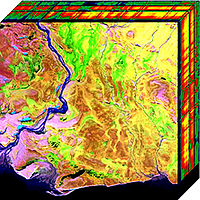
Photo from wikipedia
Remote sensing images acquired by the FY4 satellite are crucial for regional cloud monitoring and meteorological services. Inspired by the success of deep learning networks in image super-resolution, we applied… Click to show full abstract
Remote sensing images acquired by the FY4 satellite are crucial for regional cloud monitoring and meteorological services. Inspired by the success of deep learning networks in image super-resolution, we applied image super-resolution to FY4 visible spectrum (VIS) images. However, training a robust network directly for FY4 VIS image super-resolution remains challenging due to the limited provision of high resolution FY4 sample data. Here, we propose a super-resolution and transfer learning model, FY4-SR-Net. It is composed of pretraining and fine-tuning models. The pretraining model was developed using a deep residual network and a large number of FY4 A 4 and 1 km resolution VIS images as the training data. The knowledge derived from 4 km to 1 km resolution images was incorporated into FY4 B 1 km to 0.25 km resolution VIS images. The FY4-SR-Net is fine-tuned by incorporating limited 1 km and 0.25 km resolution panchromatic images, and then producing 1km super-resolution VIS images of the FY4 satellite. Using the one-day FY4 test dataset for qualitative and quantitative evaluations, the FY4-SR-Net outperformed the classic bicubic interpolation approach with a 16.12% reduction in root-mean-square error and a 2.97% rise in peak signal-to-noise ratio averages. The structural similarity value average increased by 0.0026. This article provides a new precedent for improving the spatial resolution of FY4 series meteorological satellites, which has important scientific significance and application properties.
Journal Title: IEEE Journal of Selected Topics in Applied Earth Observations and Remote Sensing
Year Published: 2022
Link to full text (if available)
Share on Social Media: Sign Up to like & get
recommendations!